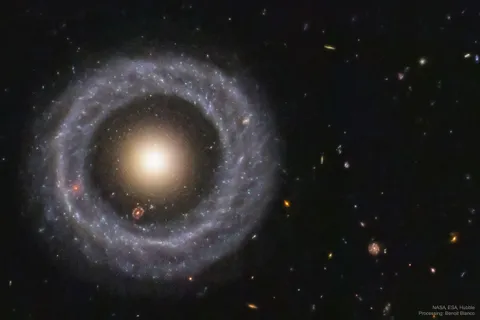Hoag’s Object spans 100,000 light-years, slightly larger than the Milky Way.
Key Takeaways
- Hoag’s Object, discovered in 1950, is a galaxy with an enigmatic ring structure.
- This “galaxy within a galaxy within a galaxy” features a perfect blue ring encircling red stars.
- A distant ring galaxy is visible in the gap, adding another layer of cosmic intrigue.
- Hypotheses include ancient collisions or rare gravitational effects, but none are conclusive.
- Ring galaxies like Hoag’s Object are extremely rare, accounting for less than 0.1% of known galaxies.
_________
The Mystery of Hoag’s Object
Nestled in the Serpent constellation, Hoag’s Object is a celestial oddity that has puzzled astronomers since Arthur Hoag first discovered it in 1950. This rare ring galaxy, located 600 million light-years from Earth, stands out due to its unusual structure: a glowing blue ring of young stars encircles a dense core of reddish stars, with a dark void separating them. Adding to the intrigue, a distant ring galaxy peeks out from the gap, creating what some have likened to a cosmic “turducken.”
Measuring roughly 100,000 light-years across, Hoag’s Object is slightly larger than our Milky Way Galaxy. Its symmetrical appearance was recently captured in a high-definition image by the Hubble Space Telescope, with image processing by geophysicist Benoit Blanco. Despite decades of study, astronomers remain uncertain about what caused this galaxy’s striking ring formation.
What Could Have Created the Rings?
Initially, Hoag theorized that gravitational lensing—a phenomenon where massive objects bend and magnify light—was responsible for the ring-like structure. However, later studies debunked this idea. Another leading hypothesis suggests an ancient collision with another galaxy. Such an event might have punched through a disk-shaped galaxy, warping its gravitational pull and creating the distinctive ring.

The collision theory, however, raises questions. If the event occurred within the last 3 billion years, radio telescopes should detect residual evidence, such as leftover gas or debris. So far, no such traces have been observed, leading scientists to believe any collision likely happened much earlier.
The symmetrical perfection of Hoag’s Object is especially puzzling. While ring galaxies are already rare, accounting for less than 0.1% of all known galaxies, none studied so far possess Hoag’s pristine structure. This uniqueness makes it difficult for researchers to find comparable examples to test their theories.
A Cosmic Enigma
With so few similar objects to analyze, Hoag’s Object remains a celestial mystery. Astronomers can only speculate about the galaxy’s origins and evolution. Its peculiar structure and the cosmic coincidence of a second ring galaxy in the background continue to captivate stargazers and scientists alike. As technology improves, future observations may finally unravel this astronomical enigma, but for now, Hoag’s Object is one of the universe’s most compelling puzzles.





Thank you I have just been searching for information approximately this topic for a while and yours is the best I have found out so far However what in regards to the bottom line Are you certain concerning the supply